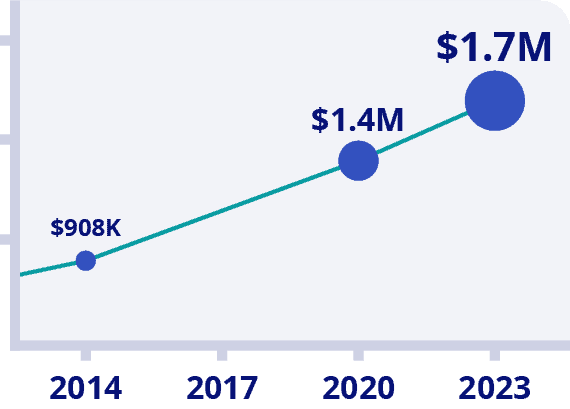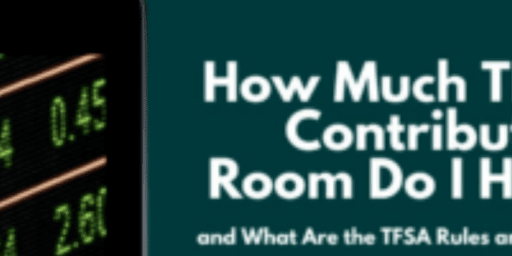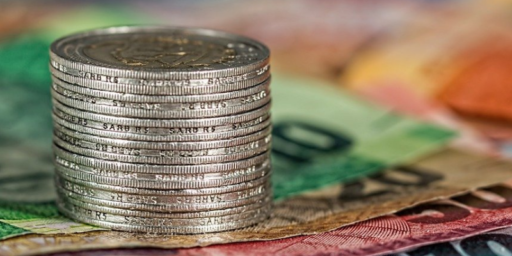Withdrawing From RRSP/TFSA to Fund Early Retirement
Moving from the accumulation stage of my professional career, to withdrawing investments in early retirement was more difficult than I would have predicted a few years ago. For those who haven’t been following me since I started writing Million Dollar Journey back in 2005, I have slowly-but-surely detailed my rise from a very average net worth, to building an investment portfolio that allowed me to reach complete financial independence.
Here are some of the key articles that I’ve written along the way (and plan to keep updated throughout 2025).
- Maxed Out TFSA and RRSP – Now What?
- Best Dividend Stocks in Canada
- Best GICs in Canada
- The Smith Manoeuvre Guide
- Canada’s Best Online Brokers
- Best ETFs in Canada
- Best Low Risk Investments in Canada
- Best Financial Advisors in Canada
You can see the latest in my personal quest here:
Completing My Personal Million Dollar Journey and My Latest Financial Freedom Update
First great job! Let’s assume you have reached your goal and quit your job, living on your dividend streams only. How would you approach this? Would you just harvest the dividend from all the accounts? Or?
I wonder if there is a optimal way of thinking about it considering taxes, the decisions you have to make as you get to 60 yrs old (CPP, OAS, …), and associated potential clawbacks.
On the topic of where the money will come from to fund early retirement, for us, we have built our wealth around Canadian dividend stocks and the best Canadian ETFs.
When it comes time to withdraw from my TFSA and RRSP, for us, the question is really how to most efficiently withdraw from the portfolio to not only fund our lifestyle but also to leave something to the estate.
Buffett puts it best along the lines of: “You should leave your children enough so they can do anything, but not enough so they can do nothing.” For others, they want to die with $0 in their bank accounts – to each their own!
Are You Saving Enough for Retirement?

Canadians Believe They Need a $1.7 Million Nest Egg to Retire
Is Your Retirement On Track?
Become your own financial planner with the first ever online retirement course created exclusively for Canadians.
Get $50 Discount With Promo Code MDJ50
*100% Money Back Guarantee
*Data Source: BMO Retirement Survey
Our Investment Accounts
As discussed in our financial freedom updates, we have the following accounts:
- RRSP x 2
- TFSA x 2
- Non-registered accounts x 2
- Corporate investment account x 1
- Small defined benefit pension accessible at age 60
Figuring out the most efficient way to withdraw from my TFSA and RRSP in retirement (as well as my other accounts) requires some advanced planning.
My MDJ co-pilot Kyle Prevost actually created a course specifically looking at DIY Canadian retirement planning that looks extensively at this exact question. You can read my personal full review of his course (called 4 Steps to a Worry-Free Retirement) by clicking here.
When it comes to this sort of advanced planning we have to keep in mind that there are several variables involved, and that there are levels of optimization. It may very well be the case that for some people, getting the low-hanging fruit taken care of – and then stepping back to enjoy life – is the better route than optimizing every single penny of retirement planning. That’s perfectly fine.
Some general rules of thumb for retirement account withdrawals
Keep tax-sheltered accounts as long as possible but watch out for the old age security (OAS) threshold which is $93,454 for 2025. After that income, OAS will be reduced by 15% for every dollar until it’s eliminated at income $125,696. So ideally you want to keep your retirement income under $93,454 (per spouse). See our Ultimate OAS guide for more details.
If you have a spouse, the ideal scenario is to keep both incomes just under the first tax bracket. In Ontario that would be $43,906, and in NL that would be $37,591. You can see tax brackets from other provinces here. Having a tax-efficient family income of $80k would make for a comfortable retirement for most families.
- Withdrawing from RRSPs early sometimes makes sense. Even though the accepted rule of thumb is to keep the RRSP as long as possible (up until Dec 31 on the year you turn 71 when you are forced to convert to an RRIF), there are a number of situations that drawing down the RRSP early has merit.
For example, say your spouse has a large RRSP balance, has health issues, and unfortunately passes away early. In that scenario, the RRSP gets transferred to you tax-free. This is great, but when you reach 71 and forced to convert the RRSP to an RRIF, you’ll be required to withdraw 5.4% of the account balance in the first year and increasing after that. If you have a $1M total RRSP, that would be $54,000 in the first year of RRIF withdrawals and increasing annually. When you add CPP/OAS on top of your RRSP income, you’ll likely start seeing OAS clawback which is essentially an additional 15% tax. Not only that, when the second spouse passes away, the large RRSP balance will likely face the highest marginal tax rate.
One strategy could be to retire a bit early, live on RRSP withdrawals, leave all other accounts intact to grow (or withdraw enough in addition to RRSP to fund lifestyle), all while delaying OAS/CPP for one or both spouses depending on health (up until 70). This would result in drawing down the RRSP balance to reduce forced taxable withdrawals at 71 which would hopefully be enough to mitigate OAS clawbacks. All this while letting the TFSAs continue to compound, and getting an increased CPP/OAS payout (the longer you delay CPP/OAS, the higher the payout).
- Income split as much as possible. If you have a spouse, the goal is to keep incomes as equal as possible to maximize income and minimize taxes. You’ll have to wait until you turn 65 for the RRIF withdrawals to be eligible for income splitting with a spouse for tax purposes, and to be eligible for the $2,000 pension tax credit. Defined Benefit Pensions can also be split with a spouse for tax purposes – this can be a huge advantage for families where one spouse is a government employee. Here are some additional income splitting ideas.
- Consider annuities. We’ve got the most comprehensive guide to Investing in Annuities in Canada of anywhere on the internet for good reason: They are an excellent way to keep life simple and to guarantee a solid (if not great) return on your investment dollars. Of course that comes with the trade-off if you were to pass away early in retirement, but you if you read that article you’ll see why we think that trade-off is worth it in many cases.
Objective Financial Partners: Save Your Retirement from the Tax Man
Are you optimizing your long-term tax strategy? Get a FREE consultation with our Top Financial Planning Company
Funding Early Retirement
Keeping those rules of thumb in mind, they will apply to every one of you in a different way. To some, they will have no issues with the OAS clawback threshold, to others, especially those with full defined benefit pensions or large RRSPs/non-registered accounts, taxation can potentially be reduced with some proper planning.
Kyle wrote an excellent guide to withdrawing from your TFSA and RRSP in which he looks at how understanding the tax rates of various types of investment income is really the key to this whole thing.
But how does this apply for someone who plans on retiring early?
From our family’s perspective, my wife and I reached financial independence in our early 40’s. We tend to keep our expenses fairly low which has been between $60k – $65k per year, all while raising two kids. I like to think that we live a balanced albeit comfortable life, which may not sound possible on $65k/year, but having no debt payments makes all the difference. We also live in a low-cost part of the country (definitely not Vancouver or Toronto).
To fund early retirement, my strategy would be the following:
- Use dividends from non-registered accounts and corporate portfolio first. Using dividends would allow for tax-efficient income, especially for early retirees. This may get to be a challenge when you approach OAS time as dividends are grossed up by 38%. So if you make $40k in taxable eligible dividends, it will look like $55k for income testing against OAS. Something to be mindful of if you are approaching senior status. But being someone with 20+ years until senior status, the tax efficiency of dividends are welcome.
- Use RRSPs for luxuries. While dividends from non-registered sources are enough for our daily expenses (at the moment), I would top-up our income by drawing down the RRSPs. While it wouldn’t deplete the RRSPs, it would help keep it to a more manageable level when we reach forced RRIF withdrawals age.
- Leave TFSAs in-tact. Combining non-registered accounts and RRSPs for spending will give us a lot of flexibility with the TFSAs. We could keep the TFSAs compounding over the years OR simply spend it. It will likely be a mix of the two. This can potentially be used as a future slush fund for luxuries such as travel, vehicles (likely one vehicle household by that point), and/or to leave to the estate/charity. Thankfully, TFSA withdrawals are not income tested for seniors benefits (as of right now!).
- Delay OAS and/or CPP – With enough income to live on via dividends and drawing down on our RRSPs, we may delay OAS and/or CPP. This would depend on our health and the size of our RRSP when we reach senior status. See our CPP guide for more details on how to defer your CPP.
Further Efficiency Needed
Going through this process has made me realize that there is an RRSP imbalance between me and the boss. If we keep going on this path, this will result in lopsided RRSP withdrawal taxation up until the age of 65 where we will be able to split the withdrawals (must be converted to RRIF first).
To mitigate this, I plan on opening a spousal RRSP (likely another account with Qtrade) to help even out the account balances over the coming years. After all, the goal is to balance retirement income between spouses to minimize taxes while maximizing income.
It’s also important to keep in mind what a flexible tool the TFSA withdrawal can be in early retirement. Here’s a few things to keep in mind:
- There is no penalty for TFSA early withdrawals (in fact, there is no such thing as withdrawing from a TFSA early, because it’s not like the RRSP in this regard, you can withdraw from a TFSA at any age).
- There is no withholding tax or income tax owing on TFSA withdrawals.
- TFSA withdrawals do not affect your OAS benefits.
- TFSA withdrawals do not affect your Canadian Child Tax Credit benefits (which is important for early retirees that still have children under the age of 18).
Early Retirement Update 2025
While I wrote this article a few years ago to help me plan my early retirement, I have actually kept working (on my own terms) after achieving financial independence a few years ago. Anecdotally, I’ve found this to be the case with a lot of folks who have reached financial independence at a relatively young age. I still enjoy the daily challenge of my job, as well as working on this website when time allows.
Kyle wrote an interesting article a few months ago looking at working after retirement in Canada. I feel like a lot of the psychological and lifestyle benefits that he details in that article apply to my situation.
In terms of a generalized update – I can’t lie, life is good. When you go to a job where you have the leverage to say, “Yup, I can continue to contribute if you want me, but it’ll have to be under the following conditions…” it really has a different appeal than when you’re grinding away to build net worth week after week.
I actually haven’t had to worry about withdrawing from my RRSP yet, as my dividend income and my work income have been enough to fund my family’s lifestyle pretty comfortably. In fact, with the 2025 RRSP season in full swing here in Canada, I recently updated my $1,000,000 RRSP article for folks starting in their 30s, 40s, or 50s, so that might be worth a gander.
With the stock market having had a really great 15-year run, I think we all have to be mentally prepared for a bit of a slowdown here at some point. For investors who have had the risk-on dial turned all the way up, it might be time to take a few chips off the table. When the downturn inevitably does happen at some point, remember these good times when you saw your net worth go up massively in just a couple years. It will help you get through the negative news headlines that try to press your fear buttons.
You should have better things to do in retirement that watch the stock market numbers after all!
Oh – I also wanted to point out in this update that I’ve gotten a ton of questions in regards to RRSP withholding tax lately. It usually goes hand-in-hand with the sentiment that “RRSPs are a rip-off.”
I can’t express this strongly enough: RRSPs are definitely not a rip-off. I’ve personally realized massive benefits from RRSPs. The rip-off theory usually comes from folks not understanding the value of re-investing their RRSP tax deduction (and accompanying refund) – and dishonest marketing from insurance people trying to sell high-commission permanent insurance plans.
In regards to RRSP withholding tax. That amount you pay when (or rather, that is “withheld” from you by the financial institution that you have your RRSP with) is just like the income tax money your employer used to hold back before they paid you. The actual amount taken off the cheque during a specific pay period doesn’t really matter. You’re going to settle up with the CRA at the end of the year anyway – and if you paid a little too much, the government is going to give you your money back via a tax refund.
So don’t worry if the online broker or the bank holds back 15-30% of your RRSP cash. It will NOT change the actual amount of tax that you owe for the year anyway. Instead, you should be focusing on legal income splitting opportunities to lower your overall tax rate in retirement.
Final Thoughts
I originally wrote this early retirement post several years ago when my early retirement target was quickly approaching, but was not yet achieved. As I update it over the years to reflect my personal experiences and research, I am proud to say that I’ve actually hit the financial independence mark.
We haven’t fully embraced early retirement yet, but the option is there if we want it – and that’s a pretty cool feeling!
I’ve also enjoyed contributing to many of the “preparing for retirement” articles that we’ve written here at MDJ over the past couple of years including topics such as:
- Safe Withdrawal rates for retired Canadians
- Working after retirement in Canada
- The best countries for Canadians to retire abroad
- How much do Canadians spend in retirement?
These articles (and helping Kyle create his DIY preparing for retirement course) have really smoothed out my own learning curve as far as feeling confident in my early retirement plan.
I’ll continue to update this article as I continue to transition from financial independence + working on my own terms, to early retirement. I’m curious what all of you who read MDJ would like to hear about as far as early retirement investing, or other types of preparation? Any questions or suggestions below would be welcome!
Are You Saving Enough for Retirement?

Canadians Believe They Need a $1.7 Million Nest Egg to Retire
Is Your Retirement On Track?
Become your own financial planner with the first ever online retirement course created exclusively for Canadians.
Get $50 Discount With Promo Code MDJ50
*100% Money Back Guarantee
*Data Source: BMO Retirement Survey
I've Completed My Million Dollar Journey. Let Me Guide You Through Yours!
Sign up below to get a copy of our free eBook: Can I Retire Yet?











Great article FT, very helpful. I am curious of the term Financial Independence. In your world Is it 20% in net income ABOVE what your annual expenses are? Merci
Hi Rando. FT rarely answers questions anymore so you’re stuck with my take. Fo rme, FI is when your investment account has 25x your annual expenses.
Very good young man. Thank you
I was wondering if you could comment on using non-registered Cdn dividend paying ETF’s or stocks that are eligible for the dividend tax credit as a tax efficiency measure. I am thinking of something like having each spouse move some capital from a TFSA into a non-registered account, collecting a small amount of eligible dividends, which if your total income is low enough, would have a effective negative tax rate. Continue this in the earlier years of retirement to defer collection of OAS to later years (and potentially CPP) and when the OAS starts, move the capital back into the TFSA to avoid the clawback. They way I understand things is say if each spouse had a $40-45K income, adding in $5K in eligible dividends would actually reduce their taxes, but the gross up on the dividends does impact OAS clawback, so you would not want to do this if you are collecting OAS. Do I have this correct? Could you potentially show some modeling around the dividend tax credit so readers can get a sense of where the benefits actually lie? I think it may be highly sensitive to the actual other income and dividend income, so needs to be below about $45K per person total (which if both spouses have about the same is fine to live off). I am getting close and want to plan to where I should be placing capital for the last few years to be in the best position overall. Currently I am trying to use the spousal contribution room to try to get to level potential incomes (as close as possible in case they change the income splitting rules).
I think I’ve read this post eight times over the years, it nearly perfectly reflects my personal situation, thank you!!
Regarding RRSP meltdown, seeking feedback regarding what I should consider over the next 5 years with hubby’s RRSP – he has no income (FIREd!) but I am still working and covering our cost of living and savings. We are in our mid forties, ~60% of our savings in tax deferred accounts, currently pretty well balanced between his savings and mine. Our current scenario anticipates ability to stay below OAS clawback thanks to income splitting, etc. but if returns do slightly better, we’ll very quickly be in clawback territory, especially when CPP kicks in at 70.
This year I’ve started RRSP withdrawal for him and reinvestment in taxable account to capture the basic personal amount (~$14k), but wondering why I wouldn’t withdraw up to next tax bracket since we don’t ever anticipate he will have taxable income below ~$45k a year once I retire. We aren’t big into dividend investing, but do have our Canadian eligible dividends in our taxable accounts.
My advisor was hesitant to even endorse the ~$14k, I’m pretty sure it’s a skills/training gap on his part, but has left me wondering if there is something I’m missing. To me a portfolio weighed towards less taxable income once the minimum withdrawals kick in would offer optimal flexibility and we could gain ~2 years of living costs from favourable tax treatment. What are the biggest risks and what-ifs I need to consider before moving an additional ~$25-$30k a year to taxable over the next 5 years?
First of all Nicole – congrats on FIRE-ing in your mid forties with enough assets to possible trigger some OAS clawback down the road. Don’t forget that as you project your portfolio growth, the OAS clawback should continue to grow as well. Now whether it should grow or not is a pretty tough debate IMO, but no party seems to want to take that debate on at the moment.
I think your idea to slowly meltdown your RRSP portfolio and transfer it to a non-registered makes a ton of sense. At the lowest tax bracket you’re essentially betting that he will have a lower tax bracket now than later in retirement – which seems like a good bet to me.
As a sidenote, anyone who thinks to ask questions on this level is probably beyond needing an advisor for anything but niche questions on estate planning etc Nicole. I wonder if you’re getting value for your money seeing as how they can’t see the benefits of withdrawing the 14K at the moment. To me, that’s a no brainger, and if they couldn’t justify why, I’d say they’re probably less informed than you are.
I’m not sure what other tradeoffs to consider. I guess one could hypothesize that tax rules could change at some point and that it might work against you as you could theoretically have less of a tax bite if you had waited – but I don’t see any evidence of that right now. At the very least he should be moving the TFSA limit worth of assets from RRSP to TFSA each year right now!
Appreciate the feedback Kyle. I’ve been assuming inflations adjusted OAS clawback threshold increases and no changes to other rules as a base case but it’s challenging to predict anything that far out as I’m sure you are well aware. At our ages any scenario is highly sensitive to single point tweaks to assumptions so it’s all a game of probabilities at this point! Although we kept hubby’s RRSP withdrawal to the basic personal amount this year I may bump it up to the next bracket going forward. My advisor is ‘free to me’ through my employer, a great perk as long as I keep a critical eye on the guidance!
Thank you for all that you do for Canadian personal finance education, I always appreciate your quality content. Happy holidays!
Great article. Would like opinions on following situation. Currently 50 and both spouse and I are planning early retirement next starting next year. Have only dividend paying stocks in TFSA and NR accounts that will provide dividends for about 50% of what I need to live on. I have rest of the 50% currently saved as cash for next 5 years. As a future tax saving strategy, I am considering “in kind” withdrawals from both of our RRSPs to our NR accounts (my RRSP is all high dividend paying investments). Since I would have no employment income from 50 to 55. I would only be paying tax on the dividends from the NR account + the in kind RRSP withdrawals. I am thinking if I can draw down my RRSP accounts (both spouse and mine) and transfer all to NR accounts (tax rate for dividend income vs general income) should save on future taxes once I start CPP/OAS/Pension at age 55. Thoughts?
Do you have a pension starting at 55 DD?
Yes. Work related via LIRA.
The strategy makes sense from a tax savings scenario for sure. With that LIRA to consider at 55 kicking you might end up paying a higher tax rate in your later years, so I see where you’re coming from. My only hesitancy with this strategy would be saying that you might be giving dividends a little too much credit. It’s definitely possible that a total returns strategy that stays full tax sheletered in the RRSP/TFSA (definitely do in kind transfers to TFSA as the year’s tick by and you have no taxable income!) could come out far ahead of a non-reg dividend-heavy strategy. Remember, companies can pause or even cut dividends right? If you’re relying on only Canadian dividend companies, the geographic risk is that much stronger (even though I’m a big fan of Canada’s large dividend-paying companies for sure).
Hi FT, let’s say I plan on retiring early and living purely off of RRSP withdrawals of $30,000. The withholding tax would be 30% but that would be much higher than my marginal tax rate if that was my only income. Would I get a tax refund for the difference?
A question – my husband is considering retiring from 9-5 job this year at age 58 and then only earning about 20,000 and then drawing on RRSPs to help pay for kids’ university, I work full time and will for another 10-15 years (I love my work) – we will mostly live on that.
I have a question about delaying CPP (and focusing on reducig RRSP) – i thought it was better for him to start collecting CPP right at 60 so that the years so that not meeting the maximum contribution level (50k or so) would not affect his average. If he delays it until 65 or more, let’s say – wouldn’t that affect the eligible amount?
Thanks for sharing. That’s something I have been thinking a little as well.
One of my thoughts right now is to have 2 years in cash (or bonds or GIC) in order to not run any risks and let the dividend income fill and replace what I am using for the current year.
What is your thinking on it?
2 years in cash would be a conservative move, but doesn’t hurt to have a little cushion in case large unexpected expenses come up! Personally I would be comfortable with about 1x-1.5x annual expenses in cash.
Retiring at 50 and using RRSP and TFSA efficiently ?
Will hit 50 soon, husband 60 soon, house paid, no debts, would like approx $40,000/year
Looking to use a good chunk of my RRSP between 50-55
When I turn 55, my husband turns 65 and should get Max OAS/GIS, I will have little income and want to make up the difference using TFSA withdrawals from 55-65
At 65, my company pension or LIF/LRIF will start, still will get husbands OAS and will have non-registered saving to use until age 70
At age 70 will have my delayed CPP/OAS, my LIF, my husbands OAS, whatever balance I have in RRSP for RRIF, balance of non-registered investments.
Obviously, trying to avoid any clawbacks and trying to stay in lowest tax bracket possible when needed.
Thoughts ?
Hi Mandy, sounds like you have a plan. Does your spouse have an RRSP? At 65, your husband can convert at least a portion of his RRSP to an RRIF which would make it eligible for pension splitting (along with the pension tax credit). The goal is to have income as equal as possible during retirement to minimize taxes. Also, does your husband have life insurance? That would help reduce risk if he were to pass away.
Thanks for the quick reply :)
He currently does not have an RRSP, but their is room and time left for him to get one. At his age 65, won’t having RRIF income start clawing back his OAS/GIS income ?
Yes he has life insurance to cover me for his lost pension income, just in case.
Is your husband working right now? If he is plannig on utilizing GIS in retirement, then contributing to an RRSP may not make sense. In his case, any savings should go towards a TFSA.
Early retirement funded with dividends can be tricky.
The $52000 you need now will become $70,000 in 10 years and $94,000 in 20 years.
Are your dividend-paying stocks or ETFs going to provide that amount? Or are you going to have to start selling to cover the difference?…
And if you are going to have to start selling, how many years is it going to be before you deplete your capital?
I feel it’s always good to have at least 50% in excess of the amount needed to live on currently. Life can be full of surprises.
Thanks for the comment Cristian. I’m not too concerned with inflation as dividend growth should more than cover it. However, as a conservative guy myself, I can see where you are coming from. Also note that in 20 years, we’ll have access to government seniors programs which will help offset required dividends from the portfolio. At this point, the question is if we will have TOO MUCH dividends that will trigger clawbacks (due to gross up). Will be running some numbers through a reputable calculator shortly and report back.
With regards to RRIF withdrawals, at the time of RRSP-to-RRIF conversion, you can decide whether the withdrawal age should be based on your own age or that of a spouse / common-law partner. So if your special someone is younger than you, then you may not be forced to take out as much as you think.
This is one-shot decision though AFAICT: it can only be done at the initial set up of the RRIF. (Though you can have multiple RRSP/RRIF accounts presumably.)
Thanks for the tip DM!
DM, if you do elect to use your younger spouse’s age, and have more than one RRSP account, can you that with only some of the accounts or do you have to apply the decision to all accounts? I think you have to do it for all accounts, no?